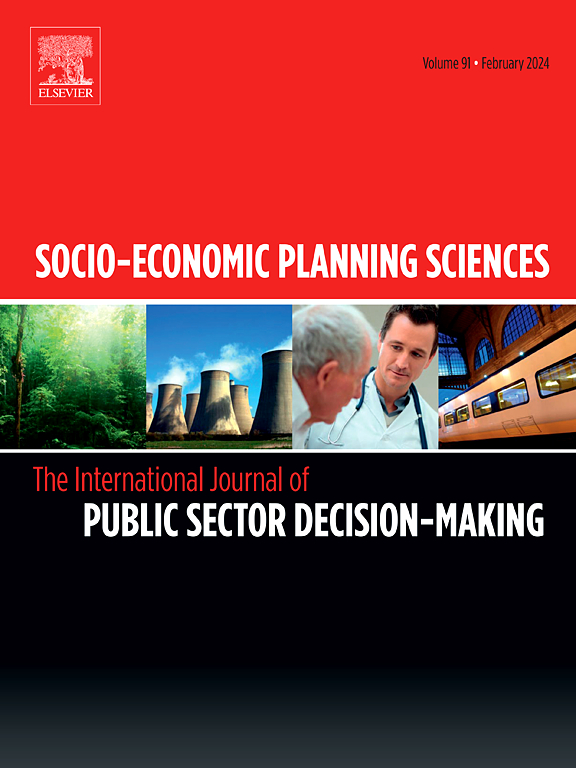Exploring social, economic, and ecological drivers of human well-being in the Qinling Mountains, China
IF 5.4
2区 经济学
Q1 ECONOMICS
引用次数: 0
Abstract
Understanding the effects of different factors on human well-being (HWB) is essential for achieving sustainable development. Recent related studies have mainly focused on the effects of socioeconomic or ecological environmental factors on HWB, while less effort has been devoted to quantitatively assessing the long-term effects of multiple variables on HWB. In this study, we applied a spatial regression model to data representing 19 social, economic, and ecological environmental variables to characterize the spatial pattern of the county-level HWB in the Qinling Region. First, we quantified the HWB in 2000, 2010 and 2020, and then, we analyzed its spatial heterogeneity in the Qinling Region. Correlation analysis, multicollinearity test, and ordinary least squares (OLS) analysis were used to identify three and four key factors in 2000 and 2020, respectively. Finally, the performances of the OLS, geographically-weighted regression (GWR), and multi-scale geographically weighted regression (MGWR) methods were compared, and it was found that the MGWR achieved the best overall performance. The model results indicated that the significant factors in 2000 included the disposable income of rural households, the number of health profession technicians, and the average annual temperature; those in 2020 included the disposable income of urban households, the number of beds in medical and health institutions, and the average annual precipitation. Economic factors had the strongest coefficient of influence, and the western Qinling Region was the most vulnerable. Selecting impact factors from multiple dimensions and conducting multi-model comparisons can help improve the reliability of our results. The results of this study provide a scientific reference for improving human well-being and for achieving sustainable development in the Qinlinig Region.
探索秦岭地区人类福祉的社会、经济和生态驱动力
了解不同因素对人类福祉的影响对实现可持续发展至关重要。近年来的相关研究主要集中在社会经济或生态环境因素对HWB的影响上,而对多变量对HWB的长期影响的定量评估较少。本文通过对19个社会、经济和生态环境变量数据的空间回归分析,对秦岭地区县域县域HWB的空间格局进行了分析。首先对2000年、2010年和2020年秦岭地区的生态承载力进行了量化,并分析了其空间异质性。利用相关分析、多重共线性检验和普通最小二乘(OLS)分析分别确定了2000年和2020年的3个和4个关键因素。最后,比较了OLS、地理加权回归(GWR)和多尺度地理加权回归(MGWR)方法的综合性能,发现MGWR方法的综合性能最好。模型结果表明,2000年农户可支配收入、卫生专业技术人员数量和年平均气温是影响农村居民健康水平的显著因素;2020年的指标包括城镇居民可支配收入、医疗卫生机构床位数和年平均降水量。经济因素的影响系数最大,西秦岭地区最脆弱。从多个维度选择影响因子,进行多模型比较,有助于提高研究结果的可靠性。研究结果为秦岭地区改善人类福祉和实现可持续发展提供了科学参考。
本文章由计算机程序翻译,如有差异,请以英文原文为准。
求助全文
约1分钟内获得全文
求助全文
来源期刊

Socio-economic Planning Sciences
OPERATIONS RESEARCH & MANAGEMENT SCIENCE-
CiteScore
9.40
自引率
13.10%
发文量
294
审稿时长
58 days
期刊介绍:
Studies directed toward the more effective utilization of existing resources, e.g. mathematical programming models of health care delivery systems with relevance to more effective program design; systems analysis of fire outbreaks and its relevance to the location of fire stations; statistical analysis of the efficiency of a developing country economy or industry.
Studies relating to the interaction of various segments of society and technology, e.g. the effects of government health policies on the utilization and design of hospital facilities; the relationship between housing density and the demands on public transportation or other service facilities: patterns and implications of urban development and air or water pollution.
Studies devoted to the anticipations of and response to future needs for social, health and other human services, e.g. the relationship between industrial growth and the development of educational resources in affected areas; investigation of future demands for material and child health resources in a developing country; design of effective recycling in an urban setting.
 求助内容:
求助内容: 应助结果提醒方式:
应助结果提醒方式:


